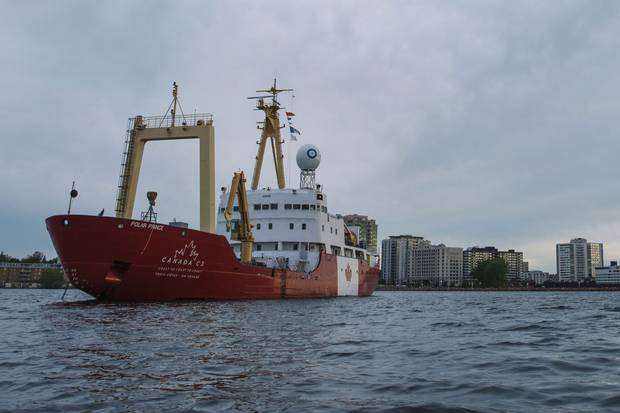It is the end of another full day of the voyage around Canada. The Canada C3 is anchored in Picton Harbour in Ontario's Prince Edward County. The sun is out and the calm waters sparkle.
The drone pilot is getting ready to send one of his machines up for an evening flight. The Zodiacs are ferrying boatloads of expeditioners back to the ship after their rounds of exploring and spreading the word about the voyage.
In the legacy room, devoted to reconciliation with Indigenous peoples, a quiet young man sings a Mohawk song, then explains the origins and meaning of traditional lacrosse. On the afterdeck, a local winemaker who heard about the voyage and wants to help out is pouring cups of white and explaining how she nurtures her vines. She is donating nine cases.
The Canada C3 project started with a simple idea: to sail around Canada on its 150th birthday in 150 days. A repurposed icebreaker will travel 23,000 kilometres from Toronto to Victoria via the Northwest Passage, coast to coast to coast. Thus C3. But the expedition aims to become much more than another Maritime adventure or anniversary party. Expedition leader Geoff Green wants to get Canadians talking not just about the wonders of the country and the waters that embrace it on all sides, but about its faults and its future.
Reconciliation with Indigenous peoples is one theme. The ship has a legacy room, blessed before Thursday's departure by an Indigenous elder. A turtle symbol graces the ship's funnel; several First Nations peoples refer to the world as Turtle Island.
Diversity is another. The expedition has selected Canadians of every background to come aboard, reaching for the widest possible mix. On an onshore hike Saturday, a spoken-word poet of Filipino heritage chatted with a country singer from the West Coast about bringing an Indigenous artist into their plan to write a song about the voyage.
Mr. Green says that when Indigenous leaders started saying that they wanted no part of celebrating the 150th anniversary of a country that had treated its first peoples so badly, he says, "it became clear we could not do this just going around blowing our horn about how great we are."
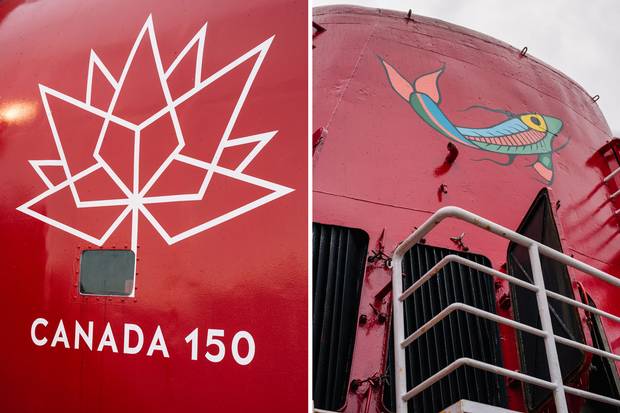
Indigenous art and the Canada 150 logo adorn the ship. Reconciliation with Indigenous peoples is a key theme of the voyage.
JOHNNY C.Y. LAM/THE GLOBE AND MAIL
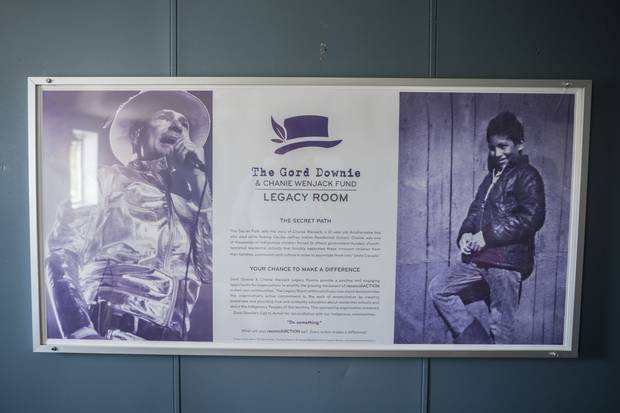
The ship’s legacy room is named to honour Tragically Hip frontman Gord Downie and Chanie Wenjack, an Indigenous youth who died escaping residential school in 1966 and is commemorated in Mr. Downie’s album Secret Path. The legacy room plays host to cultural events about reconciliation with Indigenous peoples.
J.P. MOCZULSKI FOR THE GLOBE AND MAIL
So he decided to open up the expedition, giving it a wider membership and a more reflective program. Close to 5,000 people answered an invitation to join one of the 15 legs of the journey. Mr. Green and his team chose 300: artists, musicians, scientists, naturalists, community leaders, newcomers to Canada, historians, "youth ambassadors" and Indigenous elders.
The group on the first leg, Toronto to Montreal, includes a fisheries expert who is passionate about eels and hands everyone on board an eel tattoo sticker; a border-security official whose hobby is reviewing fine whiskies; a Zodiac driver who swims with whales and once sailed an 18-foot catamaran through the Northwest Passage; a bubbly, nature-loving Grade 2 teacher from Calgary; and an international-development student who helps run a clean-water program in Yemen. That's not mentioning the regular crew who actually work the ship, a collection of characters, many from Newfoundland, with nicknames such as Mud Trout, Angry Bird and Flower.
Mr. Green himself is a veteran explorer who has made 92 trips to Antarctica and around 40 to the Arctic, among many other visits to far-flung corners of the globe. He founded the Students on Ice Foundation, which leads educational trips to the Arctic and Antarctic.
Mulling what to do for the 150th, he and his team put a map of Canada up on the wall. They did some quick calculations and reckoned it would take 148 days to cover the three coasts. Why not make it an even 150?
"For the 150th, I thought we needed something that would capture how people feel about the country," he says. "It's not just the beauty, it's everything else we have: the people, the culture, the wildlife, the history, the science."
Putting the expedition together took months of fundraising, lobbying and complex who-goes-where-when planning. The effort will cost about $10-million, with 60 per cent coming from government and the rest from a host of private sponsors. The Globe and Mail is a media partner.
Mr. Green's first task was to find a ship robust enough to make it through the Northwest Passage and big enough to carry a company of about 60. It wasn't easy. The Coast Guard had no vessels to spare. Using a foreign-flagged ship seemed wrong. Finally, he found a former Coast Guard icebreaker that was doing support work in the Atlantic oil fields off Newfoundland.
Built like a floating fortress, she is proving perfect for the job. The old helicopter hangar has become a meeting room and lecture hall, with a birch-bark canoe hung from its ceiling. A crew lounge is the place to go for late-night jam sessions by the various guitar pickers and other musicians on board.
Big, black Zodiacs strapped to the deck and lifted into the water ferry expeditioners from ship to shore. A portable laboratory in a shipping container gives on-board scientists a place to work. With a bulbous satellite dish fixed to the superstructure, the ship has all the latest technology the team needs to broadcast the story of the trip via video, social media, podcast and other platforms. Six drones are set to buzz around taking video of the action. The cargo includes 2,000 hockey sticks to be handed out to communities in the North.
Canada C3 set sail Thursday evening from a quay on Toronto's harbourfront, cheered on by a crowd of well-wishers and wished "Godspeed" by Ontario's Lieutenant-Governor, Elizabeth Dowdeswell. Before boarding for the 10-day trip to Montreal, Mr. Green held up a model of Paddle to the Sea, the carved wooden figure who rides by canoe through the Great Lakes from the top of Lake Superior all the way to the Atlantic in Holling Clancy Holling's illustrated classic, later made into a movie. Mr. Green promised he would put Paddle in the water off all three coasts.
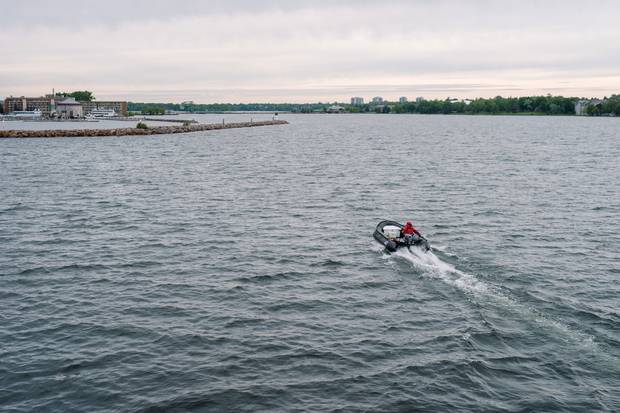
A zodiac from Canada C3 heads toward Kingston’s Confederation Basin Marina.
JOHNNY C.Y. LAM FOR THE GLOBE AND MAIL
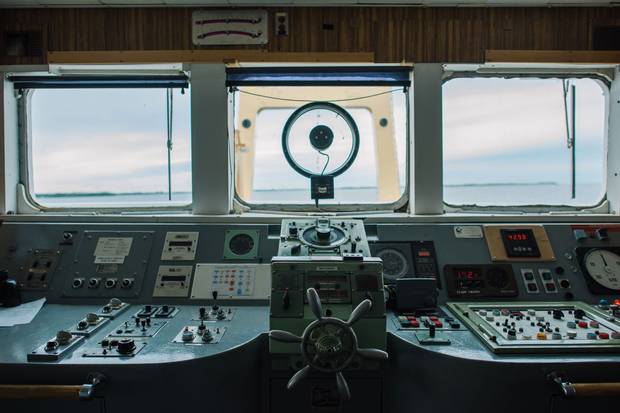
Canada C3’s $10-million journey is being mostly funded by government and a host of private sponsors, including The Globe and Mail.
JOHNNY C.Y. LAM FOR THE GLOBE AND MAIL
Canada C3 pulled away from the quay and sailed slowly out of the Eastern Gap into Lake Ontario as night fell and Toronto's brilliant skyline came alight. The next morning found the vessel off the False Duck islands near the eastern end of Lake Ontario, where scientists took water samples. From there, it sailed up Adolphus Reach to the first stop on its long journey: Picton.
Expeditioners got a warm reception and a hot supper at Prince Edward Yacht Club, where a Mohawk chief said a prayer, the mayor gave a speech and the commodore presented Mr. Green with the club burgee, a triangular flag, to fly from the ship. Absorbing the welcome, Mr. Green, who is 50, said it was finally sinking in that the voyage was under way at last. His kids, Fletcher, 9, and Nellie, 6, clung to his leg as he spoke.
The next day brought a visit to a Picton cheese fair, a guided hike in Sandbanks Provincial Park and a trip with the eel enthusiast to watch threatened American eels being fitted with electronic trackers.
If the trip's aims of wound healing, inclusion, environmental sustainability, youth engagement and all of that can seem awfully earnest – Justin Trudeau would fit right in – the effect is never stultifying. At times, the expedition has the feel of a summer camp for grown-ups – full of hugs, high spirits, heaping group breakfasts and the usual round of mishaps.
On Saturday, one participant, a young woman from Squamish, B.C., needed to be fitted for a brace and crutches after she hurt her leg; another expeditioner got taken to hospital after he had an allergic reaction to something he ate. Then the ship's toilets started backing up.
Amid all of this, a member of the C3 team stuck her head into a crowded room on the ship: "Does anyone have a corkscrew?" The wine lady had arrived.
Other times, the mood turns serious and emotion wells up. A woman from Yellowknife told a group gathered in the hangar about how her father was taken from his family to spend 14 years in residential school and how he gave up drinking when she was born to raise her properly. In Kingston on Sunday, the expeditioners took part in the KAIROS blanket exercise. Participants stand on blankets representing the lands of Indigenous peoples as the effects of European settlement take their toll. The blankets, like the land and the people, gradually diminish over time.
This is perhaps what Mr. Green was hoping for, a chance to marvel in the glories of a water-girdled land but also to reflect on its past in all its painful complexity. What began as a voyage of adventure is on its way to becoming a much deeper exploration.
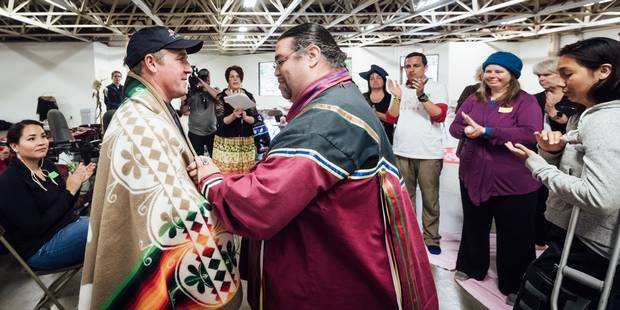
Traditional knowledge keeper Paul Carl, right, participates in a blanket ceremony in Kingston with with Geoff Green, leader of the Canada C3 expedition.
MARTIN LIPMAN/STUDENTS ON ICE FOUNDATION
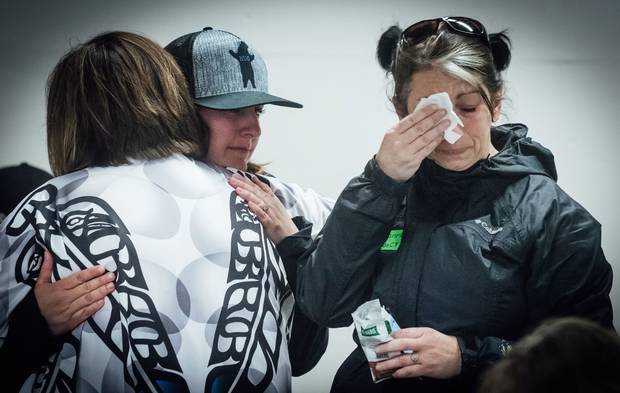
Leona Humchitt, Paula Huddy and Johanne McInnis participate in the Kingston ceremony.
MARTIN LIPMAN/STUDENTS ON ICE FOUNDATION
In photos
The boat: Daily life on Canada C3
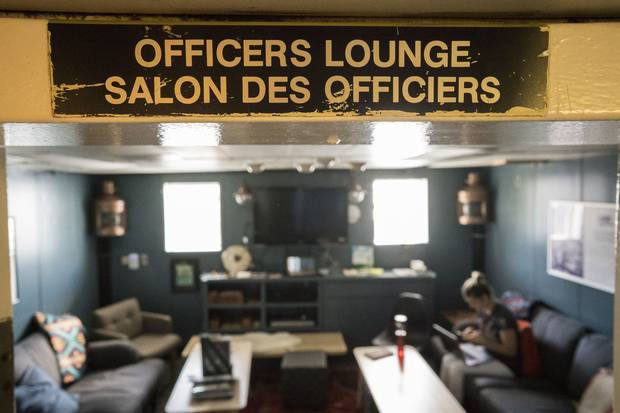
Felicity Feinman, part of the ship’s comms team, sits in the former officer’s lounge, which has been converted into the ‘Gord Downie and Charlie Wenjack Legacy Room’ for the Canada C3 voyage.
J.P. MOCZULSKI FOR THE GLOBE AND MAIL
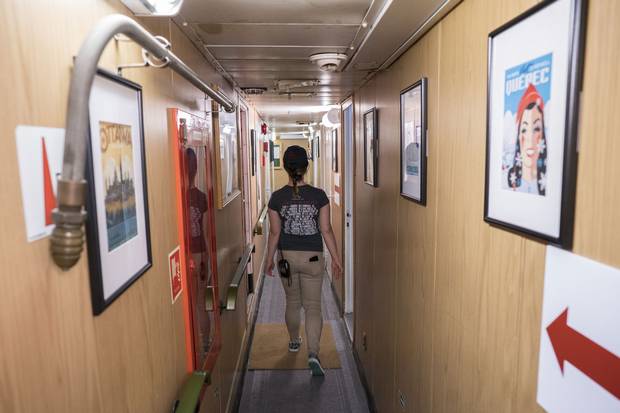
Canada C3 was a former Coast Guard icebreaker doing support work in the oil fields off Newfoundland.
J.P. MOCZULSKI FOR THE GLOBE AND MAIL
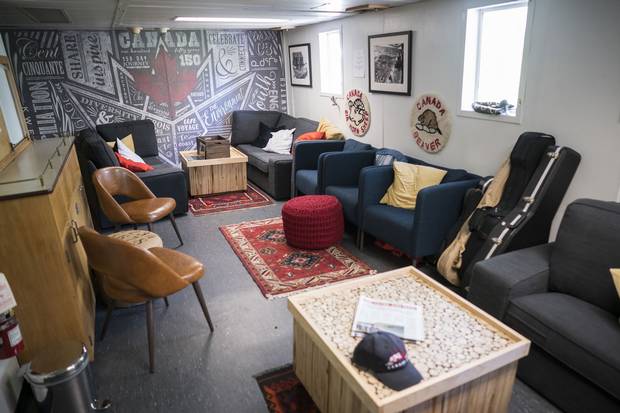
The guest lounge. Canada C3 has invited Canadians of every background to come aboard.
J.P. MOCZULSKI FOR THE GLOBE AND MAIL
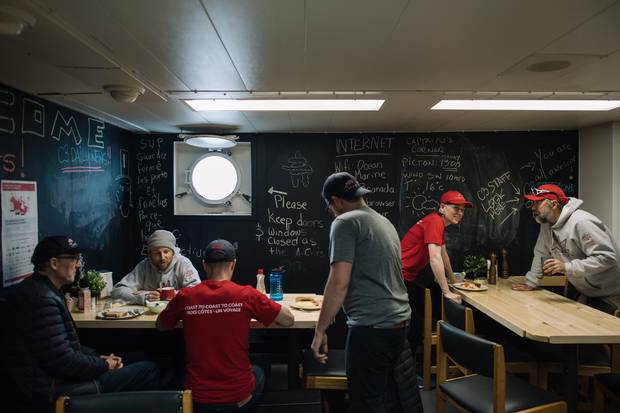
Canada C3’s crew gather for breakfast in the dining area.
JOHNNY C.Y. LAM FOR THE GLOBE AND MAIL
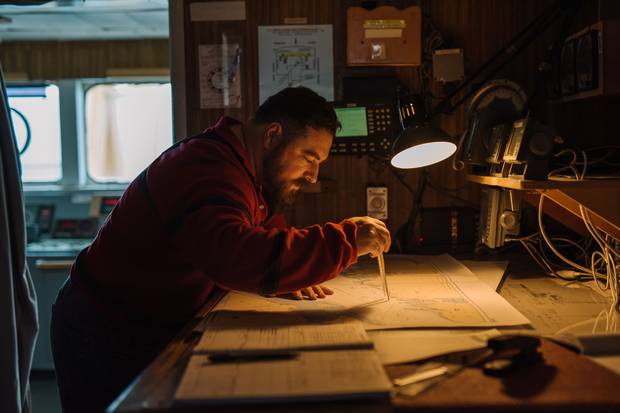
On the bridge, first mate Jim Pierce of Nova Scotia studies a map of eastern Lake Ontario.
JOHNNY C.Y. LAM FOR THE GLOBE AND MAIL
CANADA 150: MORE FROM THE GLOBE AND MAIL
